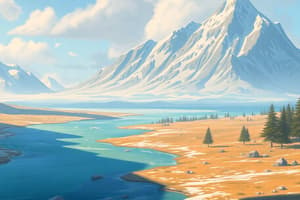Podcast
Questions and Answers
What is a primary characteristic that defines the tundra biome?
What is a primary characteristic that defines the tundra biome?
- Presence of a permanently frozen layer of soil. (correct)
- Characterized by hot, dry summers and mild winters.
- Dominated by tall, deciduous trees.
- Abundant rainfall throughout the year.
Which type of vegetation is most commonly found in the tundra biome?
Which type of vegetation is most commonly found in the tundra biome?
- Low-growing plants like lichens and mosses (correct)
- Tall, flowering plants with broad leaves
- Extensive grasslands with deep root systems
- Dense forests of coniferous trees
How do the winters in the taiga compare to those in the tundra?
How do the winters in the taiga compare to those in the tundra?
- Taiga winters are characterized by significantly more snowfall.
- Taiga winters are drier than tundra winters.
- Taiga winters are as harsh.
- Taiga winters are milder than tundra winters. (correct)
Which of the following best describes the soil conditions in the taiga biome?
Which of the following best describes the soil conditions in the taiga biome?
Which of the following is a defining characteristic of the taiga biome?
Which of the following is a defining characteristic of the taiga biome?
Which of the following factors contributes most significantly to the limited tree growth in the tundra?
Which of the following factors contributes most significantly to the limited tree growth in the tundra?
Which type of tundra is NOT based on geographical location?
Which type of tundra is NOT based on geographical location?
What is the most significant factor that differentiates alpine tundra from arctic tundra?
What is the most significant factor that differentiates alpine tundra from arctic tundra?
Which of the following characteristics is LEAST likely to be observed in the taiga biome?
Which of the following characteristics is LEAST likely to be observed in the taiga biome?
What is the most likely reason for the soil in the taiga to be mineral-poor?
What is the most likely reason for the soil in the taiga to be mineral-poor?
Which of the following BEST describes the climate conditions that contribute to the formation of permafrost in the tundra?
Which of the following BEST describes the climate conditions that contribute to the formation of permafrost in the tundra?
How does the limited precipitation in the taiga affect the types of trees that can grow there?
How does the limited precipitation in the taiga affect the types of trees that can grow there?
If a plant species is discovered that thrives in extremely acidic soil, which biome would it MOST likely be found in?
If a plant species is discovered that thrives in extremely acidic soil, which biome would it MOST likely be found in?
Why is the rate of decomposition slower in the tundra and taiga biomes compared to warmer biomes?
Why is the rate of decomposition slower in the tundra and taiga biomes compared to warmer biomes?
How might climate change impact the permafrost layer in the tundra, and what is a potential consequence?
How might climate change impact the permafrost layer in the tundra, and what is a potential consequence?
Which adaptation would you expect to find in plants that live in the Taiga biome?
Which adaptation would you expect to find in plants that live in the Taiga biome?
Considering the location of the taiga biome, which of these cities would likely experience a similar climate?
Considering the location of the taiga biome, which of these cities would likely experience a similar climate?
What is a significant difference in the primary producers (plants) found in the tundra versus the taiga?
What is a significant difference in the primary producers (plants) found in the tundra versus the taiga?
In the context of global carbon cycling, how does the permafrost in the tundra play a significant role?
In the context of global carbon cycling, how does the permafrost in the tundra play a significant role?
How does the angle of sunlight impact the biome?
How does the angle of sunlight impact the biome?
Flashcards
Tundra
Tundra
A treeless biome covered by lichens and mosses, featuring harsh, cold winters and extremely short summers. It has a layer of permafrost beneath the ground.
Permafrost
Permafrost
The permanently frozen layer of soil beneath the tundra's surface.
Taiga
Taiga
Northern coniferous forest (pine, spruce, fir), south of the tundra. Cold, severe winters, little precipitation, and acidic, mineral-poor soil.
Biome
Biome
Signup and view all the flashcards
Arctic Tundra
Arctic Tundra
Signup and view all the flashcards
Alpine Tundra
Alpine Tundra
Signup and view all the flashcards
Antarctic Tundra
Antarctic Tundra
Signup and view all the flashcards
Coniferous Forest
Coniferous Forest
Signup and view all the flashcards
Study Notes
- Tundra is also called the "treeless biome".
- Tundra is covered by lichens and mosses.
- Tundra has harsh, cold winters and extremely short summers.
- Beneath the tundra ground lies the "permafrost".
Tundra Types:
- Arctic
- Alpine
- Antarctic
- Taiga is the boreal region of coniferous forest in the Northern Hemisphere
- Coniferous examples include pine, spruce, and fir
- Taiga is located just south of the tundra.
- Winters in the boreal forest are extremely cold and severe, but not as harsh as in the tundra.
- Taiga receives little precipitation.
- The soil is acidic and mineral poor in the Taiga.
Studying That Suits You
Use AI to generate personalized quizzes and flashcards to suit your learning preferences.




